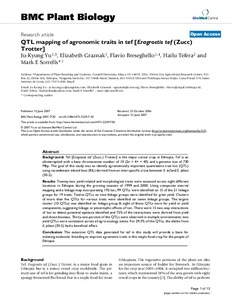| dc.contributor.author | Yu, J.K. |
| dc.contributor.author | Graznak, E. |
| dc.contributor.author | Breseghello, Flávio |
| dc.contributor.author | Tefera, H. |
| dc.contributor.author | Sorrells, M.E. |
| dc.date.accessioned | 2019-12-04T11:14:10Z |
| dc.date.available | 2019-12-04T11:14:10Z |
| dc.date.issued | 2007 |
| dc.identifier.citation | Yu, J.K., Graznak, E., Breseghello, F., Tefera, H. & Sorrells, M.E. (2007). QTL mapping of agronomic traits in tef [Eragrostis tef (Zucc) Trotter]. BMC Plant Biology, 7(30), 1-13. |
| dc.identifier.issn | 1471-2229 |
| dc.identifier.uri | https://hdl.handle.net/20.500.12478/2675 |
| dc.description | Open Access journal; Published online: 12 June 2007 |
| dc.description.abstract | Background
Tef [Eragrostis tef (Zucc.) Trotter] is the major cereal crop in Ethiopia. Tef is an allotetraploid with a base chromosome number of 10 (2n = 4× = 40) and a genome size of 730 Mbp. The goal of this study was to identify agronomically important quantitative trait loci (QTL) using recombinant inbred lines (RIL) derived from an inter-specific cross between E. tef and E. pilosa (30-5).
Results
Twenty-two yield-related and morphological traits were assessed across eight different locations in Ethiopia during the growing seasons of 1999 and 2000. Using composite interval mapping and a linkage map incorporating 192 loci, 99 QTLs were identified on 15 of the 21 linkage groups for 19 traits. Twelve QTLs on nine linkage groups were identified for grain yield. Clusters of more than five QTLs for various traits were identified on seven linkage groups. The largest cluster (10 QTLs) was identified on linkage group 8; eight of these QTLs were for yield or yield components, suggesting linkage or pleotrophic effects of loci. There were 15 two-way interactions of loci to detect potential epistasis identified and 75% of the interactions were derived from yield and shoot biomass. Thirty-one percent of the QTLs were observed in multiple environments; two yield QTLs were consistent across all agro-ecology zones. For 29.3% of the QTLs, the alleles from E. pilosa (30-5) had a beneficial effect.
Conclusion
The extensive QTL data generated for tef in this study will provide a basis for initiating molecular breeding to improve agronomic traits in this staple food crop for the people of Ethiopia. |
| dc.description.sponsorship | McKnight Foundation |
| dc.format.extent | 1-13 |
| dc.language.iso | en |
| dc.subject | Eragrostis Tef |
| dc.subject | Quantitative Trait Loci |
| dc.subject | Cereal Crops |
| dc.subject | Agronomy Traits |
| dc.title | QTL mapping of agronomic traits in tef [Eragrostis tef (Zucc) Trotter] |
| dc.type | Journal Article |
| dc.description.version | Peer Review |
| cg.contributor.affiliation | Cornell University |
| cg.contributor.affiliation | International Institute of Tropical Agriculture |
| cg.contributor.affiliation | Syngenta Seeds Inc., USA |
| cg.contributor.affiliation | Empresa Brasileira de Pesquisa Agropecuaria |
| cg.coverage.region | Africa |
| cg.coverage.region | East Africa |
| cg.coverage.country | Ethiopia |
| cg.isijournal | ISI Journal |
| cg.authorship.types | CGIAR and developing country institute |
| cg.iitasubject | Agronomy |
| cg.journal | BMC Plant Biology |
| cg.howpublished | Formally Published |
| cg.accessibilitystatus | Open Access |
| local.dspaceid | 93568 |
| cg.targetaudience | Scientists |
| cg.identifier.doi | http://dx.doi.org/10.1186/1471-2229-7-30 |

